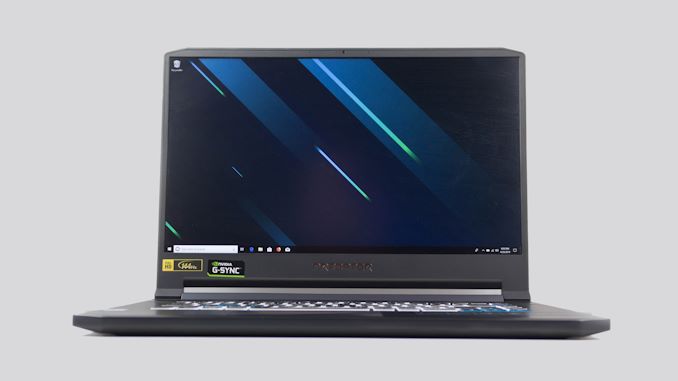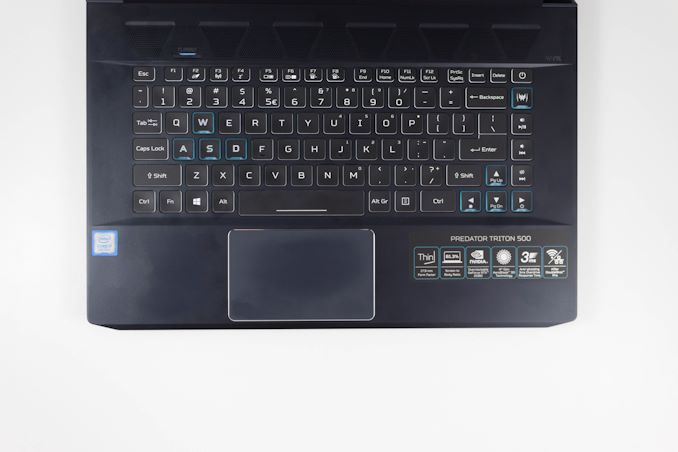The Acer Predator Triton 500 Laptop Review: Going Thin with GeForce RTX 2080
by Brett Howse on April 25, 2019 8:00 AM ESTDesign
When you think of gaming laptops, you generally think big and heavy, which makes sense due to the power requirements of top-end gaming components. A bigger laptop offers more thermal mass, and it also offers more room for cooling fans, both of which are a big help in terms of keeping a gaming laptop cool. That being said, the efficiency of modern CPUs and GPUs is at the point where you can now entertain a thin and light gaming laptop. Acer is certainly not the first to do this of course, but picking up the Predator Triton 500 for the first time drives home just how far GPUs have come, and with NVIDIA’s Max-Q program, they really can fit the top tier GPU in a thin and light chassis. At just 0.7-inches, or about 18mm thick, the Predator Triton 500 isn’t much thicker than an Ultrabook, and at 4.63 lbs, or 2.1 Kg, it is reasonably light as well.
The thin design and light weight start with the chassis, which Acer has crafted out of aluminum. On a premium laptop design, this is expected, and Acer’s execution is top-notch. The Predator logo is backlit in blue on the top of the system, but other than that the design is more muted than many gaming systems, which I think a lot of people will appreciate. Acer has also angled the top corners slightly, which is a nice touch. It’s a simple, but well-executed design.
Opening the laptop up, Acer has also jumped on another very welcome trend, offering minimal display bezels around the 15.6-inch display. There’s a bit of a chin on the bottom, which can’t be avoided if you want to fit all of the cooling and circuit boards inside. It’s true that a taller aspect ratio would solve this issue, but there is no way Acer could have found a 144 Hz IPS display panel in a 3:2 aspect, so keeping the three bezels to a minimum seems like the right solution. The angled corners at the top also allow Acer to fit the webcam in above the display.
The keyboard layout works well, offering six rows of keys. Some 15.6-inch laptops take the route of offering a number pad, which never really works well due to the narrow keyboard deck, and likely the thin bezel design wouldn’t even allow this on the Triton 500, but Acer has fit in a row of media keys, which also offers a Predator key to launch their PredatorSense software, as well as the power button. I generally frown on having the power button be a key on the keyboard, and would prefer a separate key to avoid accidentally hitting it, but since it’s slightly removed from the normal keyboard layout, this isn’t as big of a con.
The keys themselves offer backlighting, but unlike some of the competition which offers per-key RGB LEDs, Acer only allows you to customize them in three zones. Per-key RGB may seem like a gimmick, but it’s actually quite handy to color code one or two keys so you can easily find them. Acer does offer RGB backlighting though, which can be adjusted through their software, so you can pick your color, or choose one of the pre-selected layouts. One other small negative is that the backlighting isn’t activated when the trackpad is being used, so you have to be actually typing on the keyboard to activate the lighting, and keep it active. That’s not always ideal, and I prefer when backlighting is activated by both the keyboard and track pad.
Typing on the keyboard is surprisingly good. The keys are well-spaced and offer enough travel that it’s easy to get accustomed to typing on this laptop. The arrow keys are all full sized, although they do shrink the right shift key, that’s generally not an issue.
Acer’s track pad is also excellent. It is easy to be precise with it, and the trackpad is just the right size. The surface is very smooth, and I never had any issues using multi-touch gestures either. PCs have come a long way here, and it’s nice to see the adoption of the precision touchpad across so many laptops.
The left side of the laptop offers power, Ethernet, USB, HDMI, and the two audio jacks. The right side has two more USB ports, the USB Type-C port for Thunderbolt, and a mini DisplayPort output. There’s plenty of IO available, but if I was nit-picking, the layout of the cooling vents on the side block where the power cable would normally go, and considering this laptop is meant to be plugged in pretty much all of the time, having the power connector where it is makes for somewhat awkward cable management. Acer has tried to help out here by having a 90° connector, but it still isn’t ideal.
But other than that small complaint, Acer hits a lot of good notes on their design and execution of the Predator Triton 500. For a gaming laptop, it strikes a nice balance between usability, design, and functionality. The thin design and light weight make it exceptionally portable. Coupled to that is the modern thin-bezel look. Acer has designed a great looking laptop in the Predator Triton 500.















46 Comments
View All Comments
Spunjji - Friday, April 26, 2019 - link
You're looking at something similar to me; only I'm not interested in the 2080 specifically as it's comically overpriced. I'd prefer a 2060 and enough thermal headroom to get it running at something close to actual desktop 2060 performance.nVidia really dropped a bollock this generation. After having rough performance parity between desktop and notebook with Pascal (Max-Q snake oil excluded) they quietly dropped it for Turing but kept the same naming convention. The performance disparity is egregious now, while prices have been out of control since Maxwell.
vicbee - Thursday, April 25, 2019 - link
Guess there are enough 16 to 25 year olds with $3k+ to spend on gaming laptops who love the bling. Beyond my understanding.Junz - Thursday, April 25, 2019 - link
I have the triton 500 and it doesn't have Optimus but there is and option to turn on Mshybrid in the BIOS and in the predator sense software settings gear wheel there is an option for dgpu only which if turned off I believe does the same thing.Also would never have bought the laptop at full price but managed to get the $2500 model for $2100 tax free from Best Buy.
Brett Howse - Thursday, April 25, 2019 - link
Hi Junz. Thanks for the tip. I see there is an option for Optimus so I've enabled it (disabling G-SYNC) and updated the article text. Re-running the battery life tests as well.Junz - Friday, April 26, 2019 - link
No problem. I feel like I get around 6-7 hours from a full charge while running something like dev-c++ and music/YouTube playing in the background. I can't wait to see your results though.PeachNCream - Friday, April 26, 2019 - link
Wish Acer would just use Intel branded network adapters in these systems. It feels like a frisking rather than a premium experience to buy at the highest end, but get saddled with Killer NICs.Brett Howse - Friday, April 26, 2019 - link
Killer uses Intel as their base adapter now and this laptop uses the 1550 Killer which is based on the 9260 IntelPeachNCream - Friday, April 26, 2019 - link
Yes, I'd heard that was the case. The trouble is that as with any rebranding effort, a company that purchases and resells has to perform some sort of markup in order to turn over a profit. That's where Rivet Networks (RN) sits, as a middleman business between Intel and the OEMs. Normally these in-between companies offer the prospect of added value, but RN's offerings of additional software don't generally improve on vanilla Intel adapters by offering useful features. A lot of us with networking backgrounds and people that have picked up the basics of how packets find their way to the end destination and back remain unconvinced that software prioritization at the NIC makes a measurable difference and there is a dearth of supporting numbers to prove otherwise. Meanwhile features like ethernet adapter teaming (market speak - DoubleShot) are not new features and have little reason to be implemented at an endpoint node that mainly performs consumer computing. Rivet has worked at stabilizing their software so at least that problem is not as pronounced as it was in the past and the switch to buying Intel was probably a good move from a driver standpoint, yet Killer NICs selling points appear to prey on a lack of knowledge and have that snake oil flavor. I'd hope Rivet finds a different, more meaningful way to add value so they can earn the premium level the company is hoping to achieve. Before that can happen, something fundamental needs to change about what they're offering and how they're offering it....or someone needs to post some numbers that put the proof in the pudding about the claims they're making.Hrel - Saturday, April 27, 2019 - link
Acer has known reliability issues, what I'd really like to see is stress testing, since you are apparently gonna keep advertising their products. I've never had an Acer anything last more than 2 years. With that said it has been a while exactly for that reason. So, I say, abuse the keykoard, open the screen 1000 times, slide the thing off couches onto tile and carpet. Throw it in a backpack and act like you're a train commuter, pick it up, shuffle it around, toss it back down 1000 times.Until this kind of testing is done on Acer I'll never give them another cent. I just don't trust anything they make. Regardless of the components inside, assembly and quality build matter.
Junz - Saturday, April 27, 2019 - link
I've had mine for 2 weeks and what your describing is pretty much how mine is treated and so far it seems pretty sturdy. Even dropped my back pack on the floor once and freaked out when I heard the loud metallic thunk but it held up pretty well. I don't know how it'll be in 2 years but I haven't had a laptop last me 2 years yet(I'm pretty rough with my electronics), only time will tell how this one holds up.